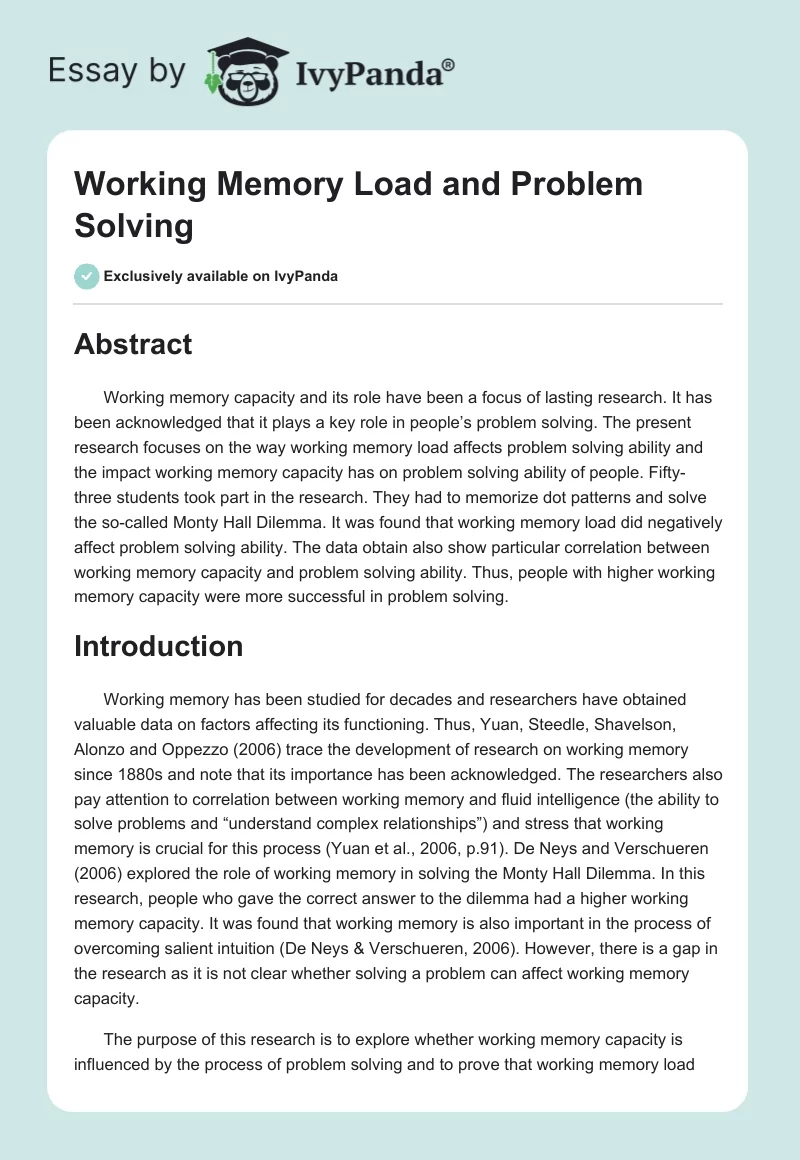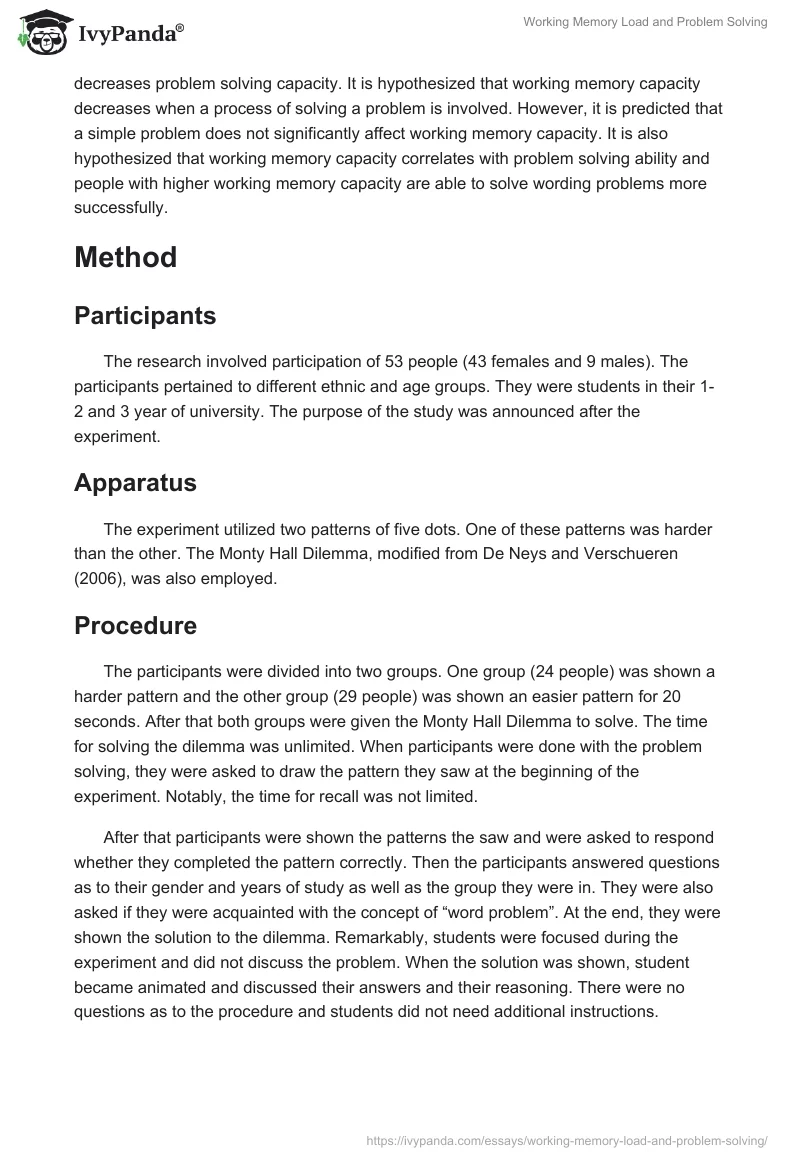Abstract
Working memory capacity and its role have been a focus of lasting research. It has been acknowledged that it plays a key role in people’s problem solving. The present research focuses on the way working memory load affects problem solving ability and the impact working memory capacity has on problem solving ability of people. Fifty-three students took part in the research. They had to memorize dot patterns and solve the so-called Monty Hall Dilemma. It was found that working memory load did negatively affect problem solving ability. The data obtain also show particular correlation between working memory capacity and problem solving ability. Thus, people with higher working memory capacity were more successful in problem solving.
Introduction
Working memory has been studied for decades and researchers have obtained valuable data on factors affecting its functioning. Thus, Yuan, Steedle, Shavelson, Alonzo and Oppezzo (2006) trace the development of research on working memory since 1880s and note that its importance has been acknowledged. The researchers also pay attention to correlation between working memory and fluid intelligence (the ability to solve problems and “understand complex relationships”) and stress that working memory is crucial for this process (Yuan et al., 2006, p.91). De Neys and Verschueren (2006) explored the role of working memory in solving the Monty Hall Dilemma. In this research, people who gave the correct answer to the dilemma had a higher working memory capacity. It was found that working memory is also important in the process of overcoming salient intuition (De Neys & Verschueren, 2006). However, there is a gap in the research as it is not clear whether solving a problem can affect working memory capacity.
The purpose of this research is to explore whether working memory capacity is influenced by the process of problem solving and to prove that working memory load decreases problem solving capacity. It is hypothesized that working memory capacity decreases when a process of solving a problem is involved. However, it is predicted that a simple problem does not significantly affect working memory capacity. It is also hypothesized that working memory capacity correlates with problem solving ability and people with higher working memory capacity are able to solve wording problems more successfully.
Method
Participants
The research involved participation of 53 people (43 females and 9 males). The participants pertained to different ethnic and age groups. They were students in their 1-2 and 3 year of university. The purpose of the study was announced after the experiment.
Apparatus
The experiment utilized two patterns of five dots. One of these patterns was harder than the other. The Monty Hall Dilemma, modified from De Neys and Verschueren (2006), was also employed.
Procedure
The participants were divided into two groups. One group (24 people) was shown a harder pattern and the other group (29 people) was shown an easier pattern for 20 seconds. After that both groups were given the Monty Hall Dilemma to solve. The time for solving the dilemma was unlimited. When participants were done with the problem solving, they were asked to draw the pattern they saw at the beginning of the experiment. Notably, the time for recall was not limited.
After that participants were shown the patterns the saw and were asked to respond whether they completed the pattern correctly. Then the participants answered questions as to their gender and years of study as well as the group they were in. They were also asked if they were acquainted with the concept of “word problem”. At the end, they were shown the solution to the dilemma. Remarkably, students were focused during the experiment and did not discuss the problem. When the solution was shown, student became animated and discussed their answers and their reasoning. There were no questions as to the procedure and students did not need additional instructions.
Results
In the group which got a harder pattern, there were 21 correct answers and 3 incorrect. In the other group, all answers were correct. A chi-squared test revealed the value 3.843 and p<0.05. As far as the answers to the dilemma are concerned, in the group with the harder pattern, 5 participants out of 24 gave correct answers. In the other group, 4 participants out of 29 gave correct answers. A chi-squared test revealed the value of 0.462 and p<0.497. Notably, there were 32 participants unacquainted with the problem. Out of these students, in the group with a harder pattern, 3 out of 14 participants gave the correct answer while only 1 (out of 18) participant gave the correct answer in the other group. A chi-squared test revealed the value of 1.814 and p<0.178.
Discussion
The results of the experiment show that working memory was affected by the problem solving process, but it had insignificant effect on this process. Remarkably, in testing effects on working memory, the value revealed was quite low which means that there is decrease in working memory capacity when a problem solving process is involved.
This finding coincides with existing data on the matter. Thus, Yuan et al. (2006) stated that working memory can decrease when a problem solving process was involved as people’s attention was distracted and they could make mistakes. The present research shows that this is true as the participants gave correct answers for the easier pattern but students having harder patterns were less successful in their task completion.
As far as the impact working memory capacity has on the problem solving process the results of the experiment are less definite. Students who were unacquainted with the dilemma gave incorrect answers in the majority of cases. It is rather impossible to state that working memory load played a meaningful role in this process as participants with lower working memory load (those having the easier pattern) were even less successful than students in the other group. Notably, p<0.497 signifies that it is unlikely that working memory load has a significant impact on the problem solving process.
More so, the same results are received with students who were acquainted with the dilemma and had more chances to solve it correctly. Thus, students predominantly gave incorrect answers and p<0.178 suggests that there is no precise correlation between working memory load and problem solving process. Such results do not coincide with data obtained by Yuan et al. (2006) who stated that there is particular correlation between working memory load and fluid intelligence.
At the same time, the data obtained also show that it is possible to trace certain correlation between working memory capacity and problem solving ability. Thus, participants with higher working memory capacity gave more correct answers when solving the problem. This finding coincides with the existing research on the matter. Thus, Yuan et al. (2006) claim there is particular correlation between working memory capacity and fluid intelligence, or, in other words, problem solving ability. De Neys and Verschueren (2006) also stress that high working memory capacity is associated with better solving problem ability. In a nutshell, people with higher working memory capacity are likely to solve wording problems more successfully than those with lower working memory capacity. Clearly, the research provides certain evidence which can support existing data and findings.
The hypothesis concerning the effects of problem solving on working memory capacity has proved to be true. The hypothesis concerning correlation between working memory capacity and problem solving ability is also true. However, this study has a number of limitations. First of all, the proportion of male and female students was inappropriate. More so, the division into groups was rather unclear. It could be more effective to divide students with a focus on their working memory capacity. Thus, their working memory capacity had to be checked first and then they could be divided into students with higher and lower working memory capacity.
It can be beneficial to expand the research. Thus, it is possible to trace correlation between gender (and/or ethnicity) and working memory capacity. It can be interesting to reveal the extent to which working memory capacity correlates with problem solving ability. For this purpose, it can be a good idea to implement a research with the use of several wording problems and patterns. Of course, it is necessary to involve more participants in the experiment. The research has to be more complex to make sure that the data are relevant.
Reference List
De Neys, W., & Verschueren, N. (2006). Working memory capacity and a notorious brain teaser. Experimental Psychology, 53(2), 123-131. Web.
Yuan, K., Steedle, J., Shavelson, R., Alonzo, A., & Oppezzo, M. (2006). Working memory, fluid intelligence, and science learning. Educational Research Review, 1(1), 83-98. Web.


